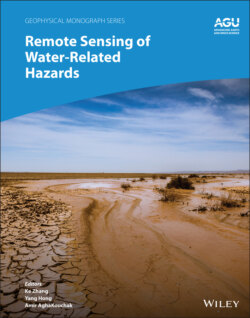Читать книгу Remote Sensing of Water-Related Hazards - Группа авторов - Страница 30
2.3.3. Flash Flood Warning
ОглавлениеThe RTI method has been applied to flash flood warnings, which effectively reduced the casualties caused by flash floods (Clark et al., 2014). Because flash floods are mainly caused by short‐duration intense rainfall, the RTI method predicts flash floods by considering the effective cumulative rainfall (R t ) and rainfall intensity (I) seven days before the flash flood occurrence. Based on the historical rainfall, the method obtains the flash flood probability under different rainfall conditions by calculating RTI and then divides the critical rainfall map into three regions for early warning (low, medium, and high possibility).
For rainfall events, the start time is defined as hourly rainfall exceeding 4 mm, and the end time is hourly rainfall falling below 4 mm for 6 consecutive hours. Then, the rainfall data corresponding to each flash flood disaster is selected. If there is no monitoring station in the flash flood disaster area, the rainfall data of the nearest monitoring station shall be employed. The RTI equation is as follows:
(9)
(10)
where RTI t is the RTI calculated at time t; I is the rainfall intensity; R t is the effective cumulative rainfall; i means the antecedent day number from one to n; α is the rainfall attenuation coefficient, mainly taken from the measured value of 0.78 in Jiangjiagou, Yunnan Province; α i is the reduction factor of the previous i day; and R i is the 24‐hour cumulative rainfall of the previous i‐day, where the initial cumulative rainfall R 0 is 50 mm, which is mainly obtained through actual statistical analysis.
Since previous rainfall was calculated using t days of accumulated rainfall, the false alarms rate is higher in certain rainfall patterns (e.g., long‐term duration and low rainfall intensity). In addition, this method does not consider the effect of intermittent rainfall and rainfall segmentation, etc. Chen et al. (2017) proposed the improved RTI method, and the equation is as follows:
(11)
where I t is the current rainfall intensity at time t (mm/h) and R t–1 is the effective cumulative rainfall one hour earlier. In equation (10), each operation needs to calculate R i separately, multiply by α i , and then accumulate. However, in equation (11), only rainfall intensity and accumulated rainfall are required, which greatly reduces the amount of calculation and contributes to subsequent large‐scale calculations.
